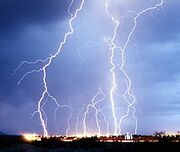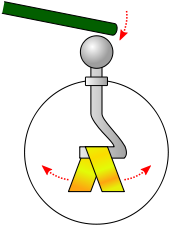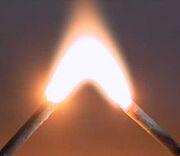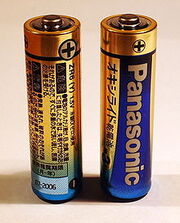Electricitat est id menghia iom physic phenomens assocyen ei presence ed ei mov uns electric charge. Quayque inkap-ye ayn un phenomen sonter magnetisme, bo sont recogniht, pon Maxwells equations, ka parts uns wahid phenomen : electromagnetisme. Divers electric phenomens sont gendels con electricitat, includend keraun, static electricitat, electric warmen, electric fawngdiens ed maung alya.
Id presence uns electric charge, quod ghehdt ses auter positive au negative, product un electric camp. Id mov iom electric chargen est un srov ed product uno magnetic camp.
Quan un charge biht placet do un stet samt un non-zero electric camp, un force vaht age ep id. Id magnitude tos force est dict ab Coulombs loy. It, sei tod charge movt, id electric camp interact con id electric charge. Yinjier maghmos tolke de un electric potential ye un certain point in rewos, est-yod egal ei wehrg kwohrn ab un extos agent behrnd-ye un unitat os positive charge ex quodlibt chusen reference pointo do tod point aun quodgvonc acceleration ed biht typic-ye midt in volts.
Electricitat est in id kerd maungen moderne technologias, esend nudt pro :
- srov quod dadwt Energia ad schowbey;
- electronique quod deilt con electric circuits qua involve active electric components ka electronentubes, transistors, diodes ed integren circuits, ed assocyen passive interconnexion technologias.
Ia electric phenomens hant esto studyet pon Antiquitat, quayque Progress in id theoric ghaben remien lento tiel ia XVIIt ed XVIIIt secules. Hatta tun, practic applications pro electricitat buir pauk, ed ne pre id end ios XIXt secule ghohd ies electromuhandis ei dahe industrial ed domestic neuds. Id oku exspansion ios electric technologia ye tod tido transformit industrie ed societat, bihnd un seuwforce pro id dwot Industrial Revolution. Electricitats extraordinar versatilitat maynt id ghehdt bihe uni quasi aunlimite menghia neuden qua includent transport, warmen, beleucen, communications ed Informatique. Electric energia est nun id weragmen ios moderne industrial societat.

Keraun est oino iom spectacularst effects os electricitat.
Historia iom aunstehgens[]
Diu pre sem gnohsa os electricitat existit, leuds conscier schocks ex electric pisk. Awa Misri textes tarikhend ex 2750 pre JC se refereer tim piskims ka im "kerauners ios Nil" ed descripseer i "protectors" em ceter pisk. De electric piskens biht iter reporten millennia serter ab i Awens Hellens, Romans ed Arab naturalistens ed physistens. Plur awi scriptors, Plinius is Veuter ed Scribonius Largus, schahideer de id karakhend effect iom electric schocks birn ab catpiskens ed electric skats, ed wois talg schocks ghohd trehce per conductor objects. Ad patients kwehndend illats kam gikht au khakethe eet prescripto touche un electric pisk samt id wehlpen od id staur fawngdien ghehdiet schife i. Kad id ausst ed prokwst proschgumt kyid aunstehgen ios identitat om keraun ed electricitat ex alyo surce est anadeble im Arabs, qui pre id XVt secule nud id sam werd (رعد) pro id keraun ed el electric skat.
Awa Cultures ambh id Mediomar gnohr od certain objects, kam ginter ghalgs, ghohd bihe ghniht med catpell kay attrage legv objects kam ptors. Thales os Miletos kwohr un serie observationen de static electricitat ambh 600 pre JC, pro-yod is credih odghneihsa magnetisit ginter, nekam minerals kam magnetite, nieudh-ya neid ghneihsa. Thales rhielt credeihnd-ye id attraction eet due uno magnetic effect, yed Science vipruv serter un diemen inter magnetisme ed electricitat. Sekwent un controverso theoria, kad i Parthawis gnohr galvanisation, yeji id aunstehgen in 1936 ios Bagdad-batterie, quod kwehct kam un galvanic cell, quayque est rhayr-yakin an tod artefact eet electric in buhsa.
Electricitat remien payn-ye meis quem un intellectual curiositat unte millennia tiel 1600, quan is Englisch muallim William Gilbert oiscripsit De Magnete, in-yod is kaur-ye studicit electricitat ed magnetisme, enderkweitend ia natural magnets ud id static electricitat producen ghneihnd-ye ginter. Is inventit id novLatin werd electricus ex id Hellen werd ἤλεκτρον = "ginter".
Ulterior wehrgs buir ducen unte ia XVIIt ed aus XVIIIt secules ab Otto von Guericke, Robert Boyle, Stephen Gray ed C.F. du Fay. Serter in id XVIIIt secule, Benjamin Franklin sokit extensive-ye electricitat, pehrnend siena maals kay finance sien paursken. In Juno 1752 iswert habiet diehn uno metallo cleich ei bors ios viel uns permadht wau ed pleukihn tod in un rlayuwent swergos. Un succession bliuten skandend ex id cleicho do id denwrnt dik odghi keraun eet electric in buhsa. Is yaschi explicit id kwecto paradoxal sulouk ios Leiden botel ka esend un ijadh kay tsange large wakels os electric charge med electricitat consistend bo positive ed negative charges.
In 1791, Luigi Galvani publicit sien aunstehgen ios bioelectromagnetique, demonstrend od electricitat eet id wassila quosmedi neurons uperdehnt signals ibs muscles. Alessandro Voltas dienchi, in 1800, kwohrn ex alternet schikhts ex zinc ed cuper, diedw im muallims uno meis wassic surce os electric energia quem ia prever nuden electrostatic machines. Id recognition os electromagnetismr, id unitat iom electric ed magnetic phenomens, est due Hans Christian Ørsted ed André-Marie Ampère in 1819-1820. Michael Faraday inventit id electric motor in 1821 ed Georg Ohm analysit mathematic-ye id electric circuit in 1827. Electricitat ed magnetisme (ed luce) buir definitive-ye yuct ab James Clerk Maxwell, besonters in eys wehrg On Physical Lines of Force in 1861 ed 1862.
Menxu preter dwidel ios XIXt secule hieb vis oku progress in electric science, dwoter dwidel vis id megst progress in electric ingenieurie. Dank leuds kam Alexander Graham Bell, Ottó Bláthy, Thomas Edison, Galileo Ferraris, Oliver Heaviside, Ányos Jedlik, William Thomson, 1st Baron Kelvin, Charles Algernon Parsons, Werner von Siemens, Joseph Swan, Reginald Fessenden, Nikola Tesla ed George Westinghouse, electricitat wohrt ex scientific curiositato do un essential alat pro moderne gwit, bihnd un sutwrnt ios dwot Industrial Revolution
In 1887, Heinrich Hertz aunstohg od electrodes beluct med ultraviolett luce creent electric bliutes meis facil-ye. In 1905, Albert Einstein publicit un papier expliend ia experimental data ios photoelectric effectios ka esend id resultat os gwayderenergia bohrn in discret quantenpacks, ab energisen electrons. Tod aunstehgen duxit ei revolution os Quantic Physique ed dank id ielgv Einstein id 1921 Nobelpris os Physique. Id photoelectric effect est also nudt in photodetectors kam ta trohven in solar panells, qua frequent-ye daughent kay tyices electricitat commercial-ye.
Id presto solid-stand apparat buit id cristalldetector xiawngja nuden unte ia 1900ens in radio receptors. Un scharibanlik viel est placen mulayim-ye in contacto con un solid cristall (kam un germanium cristall) kay detege un radio signal med id effect os contact junction. Id srovdruna ghehdt bihe ghabt in dwo forms : ka negative-ye chargen electrons, ed ka positive-ye chargen electronen deficiences kalen "torms". Id nuden material est opsst-ye un cristallin semiconductor.
Commun solid-stand apparats includent transistors (pon 1947), microprocessor chips, ed Random-Access Memorias.

Un charge ep un goldwarak electroscope causet ia waraks ad okwivid-ye repulge mutu.
Electric charge[]
Id presence os un charge gehnt un electrostatic force : charges bunge un force ep mutu, un effecto quod eet gnohn, quayque ne ghaben, in Antiquitat. Un legv ball hangend kata un strangh ghehdt bihe chargen touchend-ye id med un glas ghalg quodpet biht charget ghneihnd-ye id med wehbh. Sei un samlik ball biht chargen med un id sam glas ghalg, vidmos od id repulct preter : id charge dwinght ad bo balls abvices ud mutu. Dwo balls charget med id sam glas ghalg also repulge mutu. Lakin, sei uter ball biht chargen med id glas ghalg, ed alter med un ginter ghalg, bo balls attrage mutu. Ta phenomens buir soken ye id end ios XVIIIt secule ab Charles-Augustin de Coulomb, qui deduxit od charge se manifestet sub dwo opposen forms. Tod aunstehgen duxit ei suagnoht axiome : samcharget objects repulge mutu ed witercharget objects attrage mutu.
Id force act ep ia-pet chargen particules, hetos trendt charge oispehre bilkull egal-ye unte un conductor surface. Id magnitude ios electromagnetic force, kweter attractive au repulsive, est dict ab Coulombs loy, yunct-yod id force ei product iom chargen ed hat-yod un invers-quadrat proportion ei distance inter ia. Id electromagnetic force est meg nert, second in nerce tik pos id nert interaction, bet nekam tod force id tyehct unte vasya distances. Comparet ei maung slaber gravitational force, id electromagnetic force quod separet dwo electrons est 10^42 kers nerter quem id gravitational attraction inter ia.
Studyes hant diken od id origin os charge gwehmt ex certain types om subatomic particules qua hant id suedos os electric charge. Electric charge gehnt ed interact con id electromagnetic force, oino iom quar sulforcen os Nature. Ia familiarst bertors om electric charge sont electron ed proton. Experiments hant diken od charge est un conservet quantitate, yani, od id netto charge eni un electric-ye isolen systeme siet semper remane constant speit quakwe charges jinkdound eni tod systeme. Eni id systeme, charge ghehdt bihe transfern inter ia corpsa, kweter per directo contact, au unte id conductor material kam metallviel. Id informello lexis static electricitat se refert ei netti presence os un charge ep un corpos, biadet causen quando different materials bihnt comghnihn, transferndo charge ex oiter ad alter.
Id charge ep electrons ed protons est negative in signe, hetos ghehdt un summ os charge ses auter negative au positive. Boidos-ye, id charge bohrt ab electrons est kohnsto negative, ed tod ab protons positive, un swehdos quod orgwehmt ex id wehrg os Benjamin Franklin. Ei summ os charge est biadet dahn id symbol Q ed expressen in coulombs; ielg electron behrt id sam charge os takriban -1,6022 x 10^-19 coulomb. Charge est xihno ne tik av material, sontern abschi antimateria, ielg antimateria behrnd un egal ed witer charge idsi correspondant particule.
Charge ghehdt bihe midt ye pelu weidsa, un aw instrument esend id goldwarak electroscope, hat-yod, quayque dar in neud pro Talimdemonstrations, bihn tayn ab id electronic electromeider.

Un electric arc dadwt un energetic demonstration os srov.
Srov[]
Id mov os electric charge est gnohn ka un srov, est-yos intensitat biadet midt in amperes. Id srov ghehdt consiste quakwe movend charget particules; communst-ye ta sont electrons, bet quodkwe movend charge oiskeipt un srov. Srov ghehdt trehce per sem jects, electric conductors, bet niet trehce per un electric isolator.
Sekwent un historic boidos, un positive srov est definihn ka habend id sam direction os druna quem quodkwe positive charge id mathmount, we strehme ex id positivest part os un circuito do id negativest part. Srov ithan definihn est kalen boidosto srov. Id mov om negative-ye charget electrons ambh un electric circuit, oino iom familiarst formes os srov, est yinjier kohnst positive in id witer direction tei iom electrons. Lakin, sekwent ia conditions, un srov ghehdt consiste un druna om charget particules in uter direction, autah in sammel bo directions. Id positive-do-negative boidos est plaut-ye nuden kay simplifie tod situation.
Id process sekwent-yod srov leit per uno material est namdehn electric conduction, ed ids buhsa varyet yeji tod iom chargen particules ed ios material per-yod trehcent. Exempels om srovs include metallic conduction, quer electrons trehce per un conductor kam uno metal, ed electrolyse, quer ions (charget atoms) trehce per liquids, au per plasmas kam ia electric bliutes. Menxu ia-pet particules ghehde move destull-ye lent-ye, yando samt uno mutawassit drift velocitat om tik fractions unios millimeter pro secunde, id electric camp quod act ia seswo propaget ye takriban id syrat os luce, permittend ibs electric signals trehctum jaldi per viels.

Camplignes emanend ex un positive charge uper un platt conductor.
Electric camp[]
Id concept os electric campo buit introducen ab Michael Faraday. Un electric campo biht creen ab unmen chargen corpos in id rewos quod perambht id, ed resultet do un force buct ep ia de charges placen eni id camp. Id electric camp act inter dwo charges in un samlik weidos quem kam id gravitational camp act inter dwo masses, ed kam id, se extendt kyid aunfinia ed skaut un invers quadrat proportion ei distance. Lakin est un importanto difference. Gravitat semper act in attraction, comtragend dwo masses, menxu id electric camp ghehdt resulte in auter attraction au repulsion. Chunke large corpsa kam ia planetes daydey behrnt neid netto charge, id piern electric camp est biadet zero. Yinjier, gravitat est id uperdominant force in id universe, speit est maung slaber.
Un electric camp daydey varyet in rewos, ed ids nerce ye quodkwe point est definihn ka id force (per unitat charge) quod esiet khissen ab un stationar, neglectible charge sei id esiet placen ye tod point. Tod conceptual charge, namdehn "test charge", dehlct ses besonters smulko kay stambhes sieni wi electric camp sturbes id principal camp ed dehlct yaschi ses stantionar kay obstahe id effect om magnetic camps. Dat id electric force est definiht ka un force, ed dat force est un vector, tetos sehkwt od un electric camp est unschi vector, habend bo magnitude ed direction. Specific-ye, est un vectoren camp.
Id studye om electric camps creet ab stationar charges est kalt electrostatique. Tod camp ghehdt bihe visualisen med uno menghia imaginaren lignen quom direction ye quodkwe point est id sam quem tod ios camp. Tod concepto buit introducen ab Faraday, quos lexis "lignes os force" biht dar yando nudt nundiens. Camplignes emanend ex stationar charges hant plur magna suedsa : prest, startent ye positive charges ed endent ye negative charges; second, dehlgent entre quodkwe gohd conductor ye rect angules, ed trit, naiwo ghehdent misges ni slehnke.
Un kaul conductor corpos behrt sien hol charge ep sien extro surface. Id camp est yinjier zero ye quantlocs eni id corpos. Tod est id dastur ios Faraday kafas, un conductormetall carcasse quod isolet sien interior ud extos electric effects.
Ia dasturs os electrostatique sont important quando leit de disayne items os hogvoltage schowbey. Est un bestohmen grance ei nerce ios electric camp quod ghehdt bihe resisten med quodkwe wassila. Trans tod point, electric nibrehg ubgwehmt ed un electric arco causet un blix inter ia charget parts. Air, mathalan, dact arcs unte smulk rewsa ye nerces om electric camps qua excedde 30 kV pro centimeter. Uper weurer rewos, ids nibrehg nerce est slaber, maghses 1 kV pro centimeter. Tos visiblest natural wakya est id blix, causet quan id charge biht separet in ia aglus ab leudend airstolbs, ed auct id electric camp in id air do meger quem id ghehdt resiste. Id voltage uns plaut blixaglu ghehdt nake 100 MV ed habe un fawngdienergia tem alt quem 250 kWh.
Id campnerce est meg affecten ab prokwem conductor objects, ed id est besonters intense quando ei biht dwighen kehmbe ambh aks. Tod dastur est nudt in id voltage-tuler, isnaht-yos ak id keraun ad hihes ter, anter quem id treb id behrcskwt.

Un pair om AA-dienchis. Id + signe deict the polaritat ios potential difference inter ia dienchi borsa.
Electric potential[]
Id concept os electric potential est angh-ye yugen tei os electric camp. Uno smulk charge placet eni un electric camp kwehndt un force, ed bringhus tod charge protiev id force naudht wehrg. Id electric potential ye quodkwe point est definihn ka id energia naudhen kay bringhes un unitat test charge ex un aunfin distance lent-ye do tod point. Est biadet midt in volts, ed oin volt est id potential pro-yod ein joule wehrg dehlct bihe spens kay bringhes un charge eins coulomb ex aunfinia. Tod definition ios potential, esend formell, hat pau practic application, ed uno meis util concept est tod os electric potential difference, yani id energia naudhen kay move un unitat charge inter dwo specifiet points. Un electric camp hat id sonterkweit os ses conservative, yani id itner sohkwn ab id test charge est irrelevant : quakwe itners inter dwo specifiet points oispende id sam energia, ed yinjier un wahid wirto pro potential difference ghehdt bihe bayanen. Id volt est tem akster-ye identifiet ka id unitat os cheus pro id meiden ed id description os electric potential difference quem id lexis voltage biht meis nuden cadadien.
Pro practic ziels, est util definihes un commun reference point ye-yod potentials ghehde bihe expresst ed comparet. Menxu to ghehdiet ses aunfin, uno maung-ye meis util reference est Terra idswo, est-yod kohnsto ses ye id sam potential quantloc. Tod reference point emt naturelika id nam ardh au grund. Terra est kohnsen ses un aunfin surce egalen mikdars om positive ed negative charges, ed est yinjier electric-ye auncharge - ed khact bihe charget.
Electric potential est un scalar quantitate, yani id hat tik magnitude ed neid direction. Maght bihe ayt analog ad hoge : just kam uno muken object fallsiet unte un difference hogen causen ab un gravitational camp, sam-ye siet un charge "pehde" unte id voltage causen ab un electric camp. Tem quem ia relief maos deike ambhrissa markend ia points os egal hoge, uno menghia lignen markend ia points os egal potential (gnohn ka equipotentials) ghehde bihe risen ambh un electrostatic-ye chargen object. Ia equipotentials tehrnt vasya lignes os force ye rect angules. Dehlgent yaschi lyehge parallel ei surface uns conductor, sonst to produciet un force quod moviet ia charge bertors ad nivelle id potential ios surface.
Id electric camp eet formal-ye definiht ka id force buct ye unitat charge, bet id concepto potential permit uno meis util ed equivalent definition : id electric camp est id local gradient ios electric potential. Biadet expressen in volt pro meter, id vectoren direction ios camp est id ligne ios mierst kleitu os potential, quer ia equipotentials comlyehge prokwst mutu.